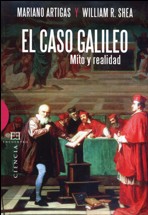You may be interested in:
The Galileo case. Myth and reality
Author: review de Mariano Artigas, William R. Shea. The Galileo case. Myth and reality. meeting. Madrid (2009). 400 pp. Spanish translation of Galileo Observed. Science and the Politics of Belief. Published by Santiago Collado.
Published in: Aceprensa
Date of publication: 8 September 2010
The Galileo Affair. Myth and Reality is not properly a story about Galileo or his famous confrontation with the Vatican. The same authors previously published Galileo in Rome. Chronicle of 500 days, where they addressed this task. In this book, which is the Spanish version of the original published in 2006, they trace the background motivations that gave rise to the various myths that have circulated throughout history about the case.
 In the pages of this book we discover how, in recent centuries, the events between Galileo and the Church have been exploited, often in a partisan and ideological way. Sometimes the trial has been used to attack the Church and to impose the idea that faith is contrary to reason and, in particular, to science. On other occasions, Galileo's actions have also been unfairly attacked, caricaturing his personality and his proposals. Many of these contributions have done justice neither to the Church nor to Galileo. Moreover, they have managed to feed a set of prejudices in one direction or another that have remained valid in many cases to the present day.
In the pages of this book we discover how, in recent centuries, the events between Galileo and the Church have been exploited, often in a partisan and ideological way. Sometimes the trial has been used to attack the Church and to impose the idea that faith is contrary to reason and, in particular, to science. On other occasions, Galileo's actions have also been unfairly attacked, caricaturing his personality and his proposals. Many of these contributions have done justice neither to the Church nor to Galileo. Moreover, they have managed to feed a set of prejudices in one direction or another that have remained valid in many cases to the present day.
Galileo as a demonstration of the thesis of the permanent conflict between science and religion; Galileo irascible and provocative, causing with his arrogant attitude all the evils that befell him; Galileo revolutionary and persecuted because his ideas were a danger to those who defended their privileged status in an unjust society and, consequently, demonstrating in this way the thesis of dialectical materialism; Galileo tortured, forced to abdicate and executed by the Inquisition; Galileo betrayed and deceived by the ecclesiastics who handled the case..... These are some of the myths that Artigas and Shea analyze in a rigorous and well documented way, mainly in the first five chapters of the book. In these pages, the main characters that are at the origin of each myth and, as far as the documentation handled allows it, the possible causes that provoked its creation and diffusion are made known.
One of the thesis defended in the book is the great complexity of the case. In reality, what happened involved many different factors that had to do with Galileo's personality, with the fact that both sides were confronted with a subject of rationality whose specificity was unknown at the time, and with a whole worldview of the natural world that had dominated for centuries.
From the sixth chapter onwards, and without losing contact with history, the underlying problems that gave rise to the confrontation are addressed. There were problems of epistemological and hermeneutical subject that fuelled the conflict and that continue to give rise to this subject of debates. This is why the Galileo case is so important for the history of science and the relationship between science and faith. It becomes clear as one reads the book that the ecclesiastics who acted in the case were wrong and made Galileo suffer, although not in the way that the myths referred to spread. But it is also clear that the mistakes made were difficult to avoid at the time and that, in any case, the infallibility of the Church as such was not compromised.
The authors highlight the falsehood of the thesis claiming that the Church has been an obstacle to the advancement of science. It is sample that it was not science that was really harmed by this case, but rather the Church. It is easier nowadays to study the Galileo case thanks to the accessibility of all the documents kept in the Vatican: they were made public in 1998. Artigas himself discovered in the course of his research an unpublished document relating to the trial, to which he devotes the ninth and penultimate chapter.
The last chapter summarises the development and the conclusions of the commission set up by John Paul II in order to arrive at the truth about what happened. The Pope's intention, in the words of the authors, was "to remove obstacles that stand in the way of a fruitful partnership between science and religion". In the thinking of John Paul II there is a harmony between the two types of knowledge which Galileo himself always defended with great foresight despite "how much he had to suffer on the part of people and bodies of the Church" (speech of John Paul II to the Pontifical Academy of Sciences in 1992).
